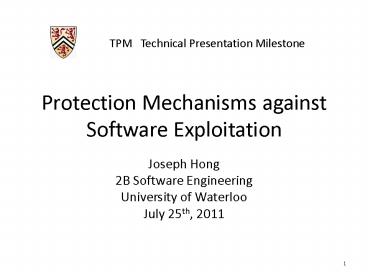Protection Mechanisms against Software Exploitation PowerPoint PPT Presentation
1 / 18
Title: Protection Mechanisms against Software Exploitation
1
Protection Mechanisms against Software
Exploitation
TPM Technical Presentation Milestone
- Joseph Hong
- 2B Software Engineering
- University of Waterloo
- July 25th, 2011
2
Outline
- Definition/Motives
- Buffer Overflow Attacks
- Protection Mechanisms
- Address Space Layout Randomization(ASLR)
- Data Execution Prevention(NX bit)
- Stack Cookie(Canary words)
- Summary
3
Definition/Motives
- Act of taking advantage of vulnerabilities to
cause unintended behaviour on computer software - Privilege Escalation
- Unauthorized Data Access
- Arbitrary Code Execution
- Motives
- Obtain government/trade secrets
- Gain reputation
- Unlock all features
- Usually carried out over the internet
4
Buffer Overflow Attacks
- Most widely used
- Low-level executables have inherent risk
- Platform/Architecture independent
- Stack-based Exploitation
- Heap-based Exploitation
5
Call Stack Overview
- Return address of the caller gets pushed
- Stack frame is allocated for stack variable
- Stack register points to the top element of the
call stack
1 int main()
2
3 int dummy
4 foo()
5
10
11 void foo()
12
13 char buffer1000
14 int i
15
20 return
21
Line 4, ESP0x6803F0
Line 11, ESP0x6803EC
Line 15, ESP0x680000
Line 21, ESP0x6803EC
0x6803F0 Dummy
0x6803F4-
0x6803EC Address to Line 5
0x6803F0 Dummy
0x6803F4-
0x680000 0x6803E4 buffer1000
0x6803E8 i
0x6803EC Address to Line 5
0x6803F0 dummy
6
Stack-based Buffer Overflow Attacks
strcpy(buffer,input)
- Find a function that takes data into the buffer
without checking its size - Pass garbage data shellcode to overwrite call
stack
0x680000 0x6803E4 buffer1000
0x6803E8 i
0x6803EC Address to Line 4
0x6803F0 dummy
0x680000 0x6803E8 Garbage Data
0x6803EC ???
0x6803F0 Shellcode
7
Stack-based Buffer Overflow Attacks
ESP0x6803EC
strcpy(buffer,input)
- Location of stack changes on each program startup
- Do not know where the shellcode will be located
at - ESP register points to the shellcode
- X86 instruction jmp esp (opcodeFF E4) sets
PCESP
0x680000 0x6803E8 Garbage Data
0x6803EC ???
0x6803F0 Shellcode
0x680000 0x6803E8 Garbage Data
0x6803EC Addr. to jmp esp instr.
0x6803F0 Shellcode
8
Stack-based Buffer Overflow Attacks
ESP0x6803EC
strcpy(buffer,input)
- Find FF E6 in one of core modules
- Set return address to this instruction
- Return pointer now points to jmp esp
instruction - Also known as jump trampolining
0x680000 0x6803E8 Garbage Data
0x6803EC ???
0x6803F0 Shellcode
0x680000 0x6803E8 Garbage Data
0x6803EC 0x7C941EED
0x6803F0 Shellcode
9
Address Space Layout Randomization(ASLR)
- Precise location of jmp esp must be known for
successful attack - ASLR works by randomizing the base address of
modules - The address will change on every startup
- On 32-bit system upper 16bit is randomized
- On 64-bit system middle 32bit is randomized
- Very effective due to much greater bits of
entropy - Supported by all mainstream OSes
- Prone to Heap Spray Attacks
10
Heap Spray Attacks
- Can be used to bypass ASLR
- Used by most browser exploits since 2004
- Allocates huge amount of memory using javascript
- Filled with NOP instruction (No-Operation) with
shell code at the end (NOP slide) - Jump to random address and hope to land in the
allocated memory - Surprisingly very high chance of success
11
Heap Spray Attacks (example)
- var x new Array()
- // Fill 200MB of memory
- // with copies of the
- // NOP slide and shellcode
- for(var i0ilt200i)
- xi nop shellcode
0x680000 0x6803E8 Garbage Data
0x6803EC Addr to Probable Nop Slide
12
Data Execution Prevention(NX/XD bit)
- No-eXecute bit(AMD) or eXecute Disable bit(Intel)
- First introduced in 2000 by AMD for x86
Architecture - Controls executability of memory page
- Shell code in the stack/heap will not be directly
executable
13
Stack Cookie
- Also called as canary words
- Values placed between stack frame and return
address - Checks for corruption before returning
- Corruption indicates buffer overflow
- Enabled by default on GCC(as Stack-Smashing
Protector) and Visual Studio(/GS flag)
14
Stack Cookie
0x680000 0x6803E4 buffer1000
0x6803E8 I
0x6803EC cookie
0x6803F0 Address to Line 4
0x6803F4 dummy
- Compiler adds automated checking function around
the implementation - Aborts the program when a corruption is detected
void foo() char buf256
strcpy(buf,input)
- random_cookierand()
- void foo()
- int cookierandom_cookie
- char buf256
- strcpy(buf,input)
- if(cookie!random_cookie)
- abort()
15
Stack Cookie
- Provides maximum protection
- Level of protection depends on many factors
- Is the cookie guessable/calculatable?
- Where is the original cookie located?
- Original cookie may be overwritten
- Does it raise exception or simply abort the
program? - Exception handler may be overwritten (SEH
Overwrite attack) - Aborting program is usually safer
- Has performance overhead
16
Best Practices
- These are the last line of defence
- No protection mechanisms are completely
fail-proof - Consider security from ground up
17
Summary
- Definition of software exploitation
- How stack buffer overflow works
- Mechanisms that are in place
18
References
- Reverse Engineering and the ANI Vulnerability
Alex Sortirov - lthttp//www.phreedom.org/presentations/reverse-eng
ineering-ani/gt - Exploit (computer security) lthttp//en.wikipedia.o
rg/wiki/Exploit_(computer_security)

